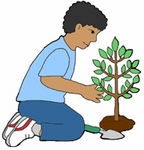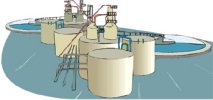
Worksheets and No Prep Teaching Resources
Reading Comprehension Worksheets
Caring for Earth

Caring for Earth
 Worksheets and No Prep Teaching Resources Reading Comprehension Worksheets Caring for Earth |
 Caring for Earth |
| edHelper's suggested reading level: | grades 7 to 9 | |
| Flesch-Kincaid grade level: | 9.07 |
|
The Wet Treatment, Part 2
By Trista L. Pollard |

|
 1 In The Wet Treatment, Part 1, we explored the destination of our wastewater and the beginning of the water treatment process. Let us continue our exploration by moving on to the fourth step. Removing sludge is the next part of the treatment for our wastewater. Sludge, which is the organic part of sewage, settles to the bottom of the tanks and is pumped to large tanks called digesters to be processed. A small part of water is removed during this step. This is called thickening. Removing scum is the fifth step in the treatment process. Scum is grease, oils, plastics, and soaps that are in the wastewater. When the sludge settles to the bottom of sedimentation tanks, lighter materials float to the surface of the water. The scum is skimmed from the surface of the water using slow-moving rakes. The scum is thickened and sent to the digesters with the sludge.
1 In The Wet Treatment, Part 1, we explored the destination of our wastewater and the beginning of the water treatment process. Let us continue our exploration by moving on to the fourth step. Removing sludge is the next part of the treatment for our wastewater. Sludge, which is the organic part of sewage, settles to the bottom of the tanks and is pumped to large tanks called digesters to be processed. A small part of water is removed during this step. This is called thickening. Removing scum is the fifth step in the treatment process. Scum is grease, oils, plastics, and soaps that are in the wastewater. When the sludge settles to the bottom of sedimentation tanks, lighter materials float to the surface of the water. The scum is skimmed from the surface of the water using slow-moving rakes. The scum is thickened and sent to the digesters with the sludge. |
Create Weekly Reading Books
Prepare for an entire week at once! |
| Leave your feedback on The Wet Treatment, Part 2 (use this link if you found an error in the story) |
 |
Caring for Earth
|
 |
High School Reading Comprehensions and High School Reading Lessons
|
 |
Earth Day Activities, Printables, Worksheets, and Lesson Plans for Kids
|
 |
Science
|